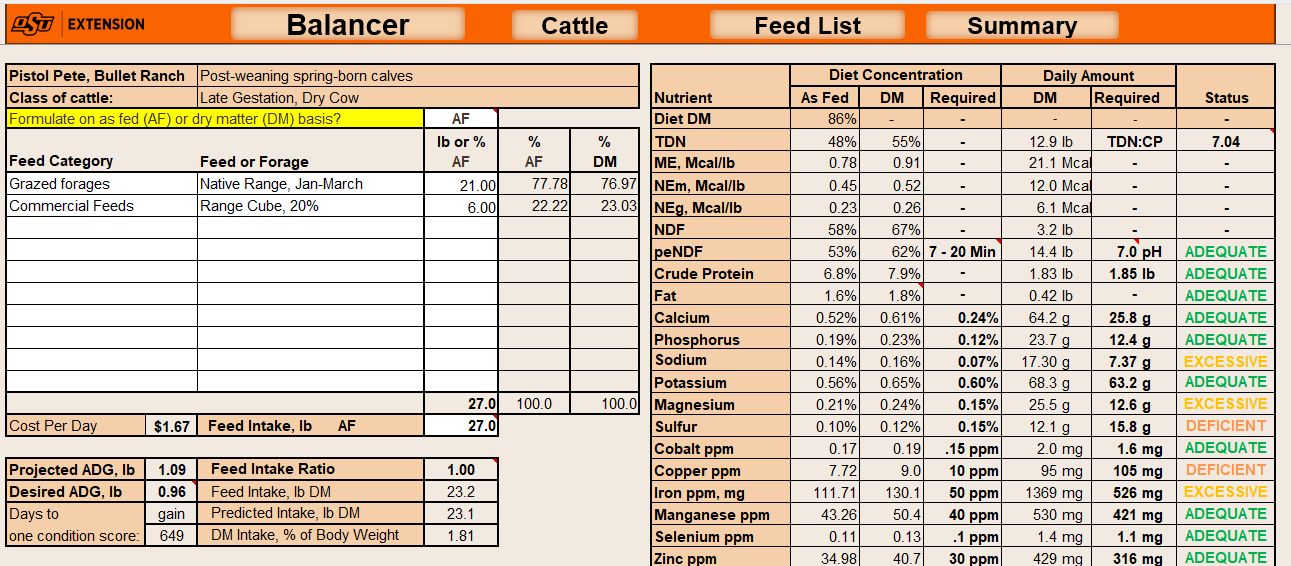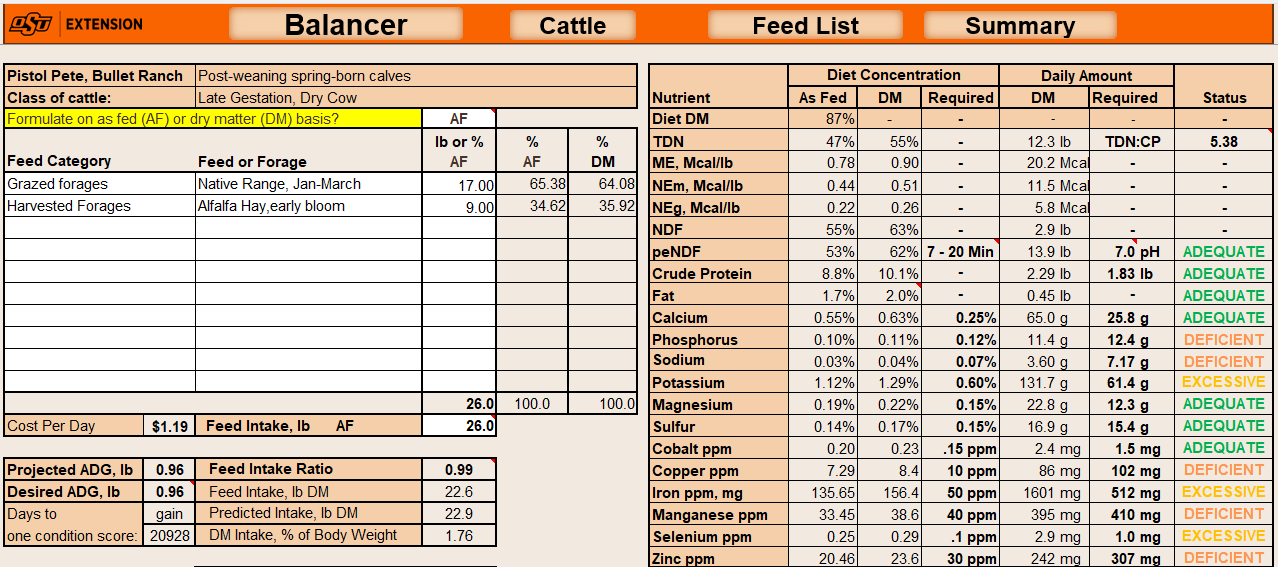Cow-Calf Corner | December 25, 2023
Wrapping up Christmas Presents and Cattle Markets
Derrell S. Peel, Oklahoma State University Extension Livestock Marketing Specialist
The final Cattle on Feed report of the year showed that December feedlot inventories were 102.7 percent of last year at 12.006 million head. Among the four largest cattle feeding states, Texas (2.91 million head) and Kansas (2.50 million head) were up the most, with Texas up four percent and Kansas inventories up seven percent year over year. Nebraska (2.58 million head) and Colorado (1.03 million head) were both down one percent in feedlot totals compared to one year ago. The top four states represent 75.1 percent of December 1 feedlot inventories. Feedlot inventories in number five Iowa are up two percent year over year at 640 thousand head and California, the sixth largest cattle feeding state, had a December feedlot total of 510 thousand head, up one percent over one year ago. Oklahoma, Idaho, Washington, and Arizona round out the top ten cattle feeding states.
November feedlot placements were 98.1 percent of last year, smaller than last year after two months of year over year higher placements in September and October. The placement total was a little larger than average expectations at the top end of pre-report estimates. Although feedlot inventories are 2.7 percent larger than one year ago, total feedlot placements the last six months (which account for 96.2 percent of the December feedlot inventory), are down 0.3 percent from the same June-November period last year. This means that the larger feedlot inventory now is due to a slower feedlot turnover rate and not because of increased total feedlot production. This is reflected in the November feedlot marketings that were down 7.4 percent year over year. A slower feedlot marketing rate raises concerns that feedlots may not be staying current in marketings. Steer carcass weights pushed to new record levels in the past month with weekly weights at 940 pounds in late November and early December. (Heifer carcass weights peaked at 854 pounds recently, just one pound shy of the largest weekly heifer carcass weight in January 2022.) However, indications are that the heavier carcass weights reflect deliberate marketing intentions (feeding cattle longer) rather than a systemic lack of currentness in feedlots.
Feeder and fed cattle prices increased the week before Christmas. The five-market cash fed price on December 22 was $170.50/cwt., up roughly $2/cwt. from the previous week. On a weekly basis, fed cattle prices have average 22 percent above year earlier levels in 2023. Feeder cattle prices were sharply higher in Oklahoma auctions for the final week of sales in 2023. The price of 475 pound, medium/large, #1 steers was $317.52/cwt, up 44 percent from one year ago, and have averaged 37 percent higher year over year across all weeks this year. The price of 775-pound steers was $225.87/cwt., up 28 percent year over year. These big feeder cattle have averaged 31 percent higher year over year on a weekly basis in 2023.
Merry Christmas and a Happy New Year to all.
2023 Year In Review
Mark Z. Johnson, Oklahoma State University Extension Beef Cattle Breeding Specialist
The end of 2023 arrives at a time when we, as cattle producers, have a great deal to be thankful for. Strong cattle prices and historically strong profit opportunities have made headlines in the past year. Overall, 2023 should close out as profitable year for all segments of beef cattle production (cow-calf producers, stocker operations and cattle feeders). This is historically rare. Current low cattle inventories indicate high value of cattle of all classes for the next several years. The market value of purebred seedstock should be supported in the future as the nation re-populates with cows. The drought released its grip on Oklahoma during 2023, timely rains and good management permitted recovery of grazing lands and our hay inventory ebbed back higher.
As we look forward to 2024 in the cattle business, keep the following in mind:
- When the nation's cow herd inventory starts to increase remains in question. What is certain however is the opportunity to "rebuild better." Sound selection and mating decisions now will enable you to regrow cow numbers with a biological type that fits your production environment, management and marketing plan. Mature cow size, level of milk, fertility and breed composition all contribute to cows that best fit your production environment.
- It's not just the cattle, remember to manage and care for your soil and plants. Grazing ecosystems can take several years to recover from drought. At the beginning of future grazing seasons, manage to give your rangeland a competitive advantage over grazing pressure. Don't re-stock until your pasturelands are ready.
- Low cow inventories support higher value of cattle. That being said, keep input cost, interest rates and inventories of feedstuffs in mind when making future business decisions.
- Finally, The cattle business is based on having an available forage base that cattle can graze and turn into beef. The key to profitability is to find a long-term balance of forage produced, other input expenses and production levels.
It is the ingenuity, perseverance, work ethic and "can do" attitude of America's cattle men and women, and ag producers that permit us to enjoy the highest quality beef produced in the world and spend a relatively small percentage of our disposable income on food. Merry Christmas and Happy New Year! Thanks for reading and best of luck to cattlemen and women in 2024.
Opportunity: Using Alfalfa as a Supplement for Beef Cows
Paul Beck, Oklahoma State University State Beef Cattle Nutrition Specialist
It is well past time to consider supplementation options for getting our cows through the winter while preparing them for spring calving. Although down some, feed prices do not feel like they have returned to levels we are used to. Good growing conditions have blessed us with better hay production than we have seen in the last couple of years, so using high-quality hay as a supplement can definitely be an option this winter. The USDA Oklahoma Direct Hay Market Report for December shows
(Oklahoma Direct Hay Report) that Good/Premium grade alfalfa in 4 x 4 large square bales is pricing at $180/ton
while Premium/Supreme alfalfa is pricing at $200 per ton. Compare this to 20% Range
Cubes priced at $10/bag ($400 per ton). Good grade alfalfa is 18 to 20% crude protein
and 58-60% total digestible nutrients. Premium grade is 20 to 22% crude protein and
Supreme is >22% crude protein. These nutritive qualities make alfalfa hay an attractive
option compared to feeding cubes.
Using the Cowculator Beef Cattle Nutrition Evaluation program (available at OSU Extension Cowculator) we see that a 1250 pound cow in the third trimester of gestation grazing stockpiled
native range in January and February would need 6 pounds of supplemental 20% Range
Cubes per day to meet protein and energy needs. This would cost $1.67 per cow each
day.
Figure 1. Feed ration with Range Cubes.
Compare this to Premium alfalfa hay. The same cow would need 9 pounds of alfalfa per day to meet protein and energy requirements, but the daily cost decreases to $1.19/cow. Both research and past experience has shown us that alfalfa is an effective supplement for wintering beef cows.
Figure 2. Feed ration with Premium alfalfa hay.
There are several points to consider:
Supplementing forage will result in reduced intake of other forages, but will have
less impact on forage digestion than concentrate supplements at higher feeding levels.
Do not feed every day, cows have been known to wait at the gate when they know that
supplemental hay will be delivered daily (Dana Zook OSU NW Area Livestock Specialist
calls this "Spoiled Cow Syndrome"). Provide supplements on alternating days or up to every 3rd day to balance distance
of travel and amount of supplement required even at high supplementation rates does
not appear to disrupt grazing activity during off days.
Dana Zook presented 'Alfalfa as a Winter Protein Supplement' as part of the Ranch's Thursday Lunchtime Webinar Series on October 21, 2021. Her slide set is available on: Thursday Ranchers Lunchtime Series.
Dana's Rancher's Thursday presentation along with a presentation by Dr. Shane Gadberry, University of Arkansas, on using feed additives and probiotics for beef cows from October 21, 2021 are available at: OSU Extension: Controlling Winter Feed Costs - Oct 21, 2021.


